
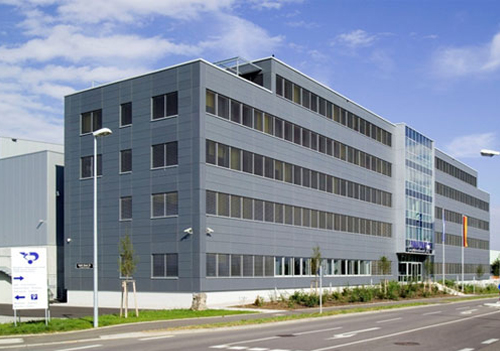
| object | logistics center Panalpina |
| constructor | Stuttgart Panalpina Welttransport GmbH |
| planning | Ingenieurbüro Gedinia, Korb |
| construction year | 2005 |
| heat source | earth |
| heat pump | 2 x DS 6271.3, 220 kW |
| collector | 11 probes à 150 m |
| operation mode | underfloor heating: 7000 m2 , space cooling: RLT-Anlage |
Panalpina Welttransport GmbH, Stuttgart is a subsidiary of the Panalpina Group. In winter, the temperature of the 8400 square metre hall must be maintained at approx. 11 °C. In addition, there is an approx. 4500 square metre area in administration that requires heat or air conditioning.
The premises features 40 geothermal probes, each driven 150 m into the ground. Prior to drilling, a response test was performed. It provides information on the heat extraction rate of the soil. At the first attempt, conclusions about the number of probes can be drawn from the known soil conditions. Such an assessment is normally sufficient for smaller construction projects.
However, for systems exceeding 50 kW, the conclusive response test pays for itself by a possible reduction in metres drilled and complaint-free heat supply. The number of precisely 40 probes is the result of the respective on-site analysis.
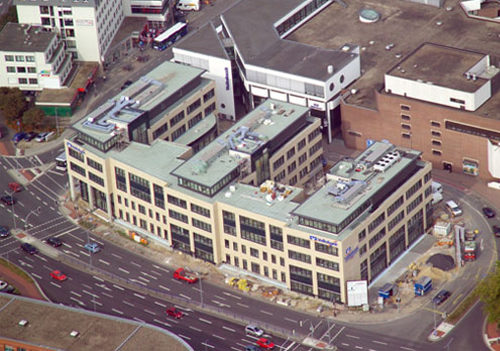
| object | bank Volksbank Rheine |
| constructor | Volksbank Nordmünsterland e.G., Rheine |
| planning | Ingenieurbüro Temmen VDI, Rheine |
| construction year | 2005 |
| heat source | earth |
| heat pump | 3 x DS 6388.4, performance total 600 kW |
| collector | 50 vertical probes à 130 Meter |
| operation mode | heating/cooling |
The requirement of management to justify and take responsibility for internal decisions towards the customer exists in no other form of business organisation than in the registered cooperative. This is based on the fact that the savers themselves participate in the highest board of the registered cooperative, i.e. the general meeting. They are the share holders.
Thus, the specifications for the planning and construction of the new head office of the Volksbank Nordmünsterland e.G. in Rheine contained the unwritten rule to be particularly careful with the capital of the investors. This rule was of course observed by the management of the financial institution. Thus, for instance, the consideration of all alternatives for efficient heating and cooling of the building led to a geothermal heat pump system. Comfort and economic efficiency were - and are - clearly in favour of this sustainable solution.
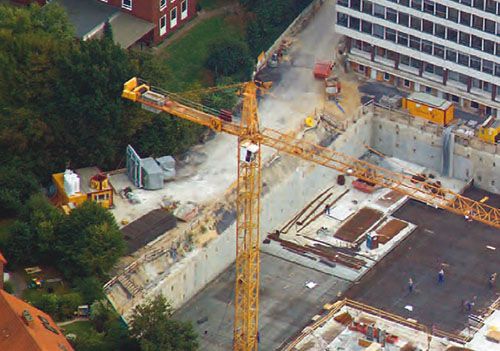
| object | new construction Landwirtschaftlicher Versicherungsverein Münster LVM |
| constructor | s. o. |
| architect | Duk-Kyu Ryang/ HPP Architekten, Düsseldorf |
| planning | Ingenieurbüro Nordhorn, Münster/ TEB, Vaihingen/Enz |
| earth probe area | TERAMEX, Herne |
| construction year | 2008 |
| heat source | earth |
| collector | 92 vertical probes, 70-100 Meter |
| operation mode | heat source |
One of Germany's largest geothermal probe fields heats the new building of the Landwirtschaftlichen Versicherungsvereins Münster LVM. The probes, located at a depth between 92 and 100 metres, control the concrete core temperature. Due to the harmonious coordination of the architecture and energy concept, the object was awarded the Regional Prize for "Energy-efficient Building for the Future" by the two ministries for Construction and Transport and Economic Affairs and Energy of North Rhine-Westphalia.
The primary energy requirement of the insurance company facility (3 million customers, 9 million contracts, 2.3 billion turnover) is only 44 kWh/ m²a. The entire office area is 8,800 m², the temperature controlled area (heating and cooling) 6,025 m². Concrete core tempering ensures a comfortable room temperature.
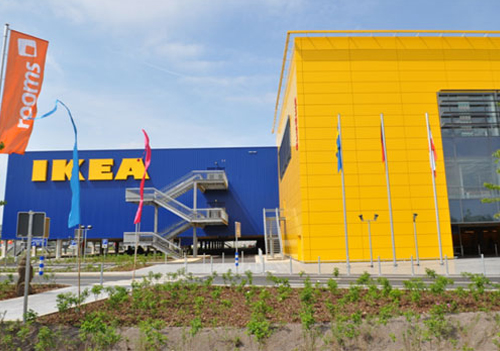
| object | nex construction IKEA, Butzweiler Hof, Köln |
| constructor | IKEA Deutschland GmbH & Co. KG |
| planning | Schindler Ingenieurgesellschaft, Dietzenbach |
| construction year | 2009 |
| heat source | groundwater(geothermal energy) |
| heat pump | 2 x DS 6500 (380 and 480 kW) |
| well | 4 wells (extraction and injection wells) 70 m deep |
| operation mode | heating/cooling |
In March 2009, IKEA launched its second store in Cologne - at that time Germany's largest IKEA branch. In ‚Am Butzweiler Hof’, the name and location of the store, IKEA focuses increasingly on the use of renewable energy in line with the internal global sustainability strategy.
The low temperature circuit is based on two heat pumps (type DS, 380 and 480 kW, power control 75-100 %). The heat is extracted from the groundwater extraction wells. The control centre is located on the 1st ground floor.
When heating, the cool-down rate of the well water recovered may not exceed 3 K in accordance with the requirements of the Cologne water authority. The engineers dimensioned the circulation volume, the heat exchangers and the heat transfer into the sales areas (radiant ceiling panels, underfloor heating) according to this spread.
The same jump of 3 K also applies to cooling: The heat-up rate may not exceed 3 K. Thus, with regard to the average natural well water temperature of 14 °C, the applicable limits for building technology are 11 and 17 °C.
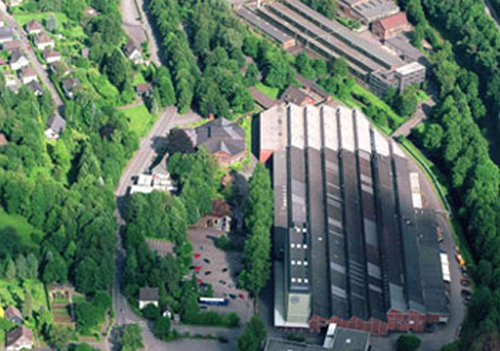
| object | test center Bergische Achsen, Wiehl |
| constructor | BWP Bergische Achsen KG, Wiehl |
| planning | CommonConsult/Metternich Haustechnik/Integral Ingenieure |
| construction year | 2008 |
| heat source | Erdreich |
| heat pump | DS 5072.3, 52 kW heat output, 39 kW cooling output |
| collector | 10 vertical probes à 99 Meter |
| heat requirement | low energy house |
| function | heating/passiv and activ cooling |
Since autumn 2008, the heat pump system at the automotive supplier Bergische Achsen KG controls the temperature in the upper office floor of a two-story building as well as in the QS test centre on the ground floor. QS stands for quality and safety. The test is subject to the most stringent requirements. To prevent the measurement results from being compromised on the giant marble tables, the room temperature deviation is not to exceed +/- 1 °C of the 20 °C target temperature. Despite its inertia, the planners CommonConsult as well as Metternich Haustechnik, Windeck, suggested concrete core activation, supplemented by solar shading elements and a ventilation system as dynamic component.
Based on this, the client approved the plans. The economic efficiency was clearly against the alternate system of gas heating and air conditioning. Even though the investment costs of both solutions were at a similar level, the engineers determined a 1:4 difference in operating costs. Therefore, the cost of the heat pump system is only one quarter of the annual costs compared to the gas version.
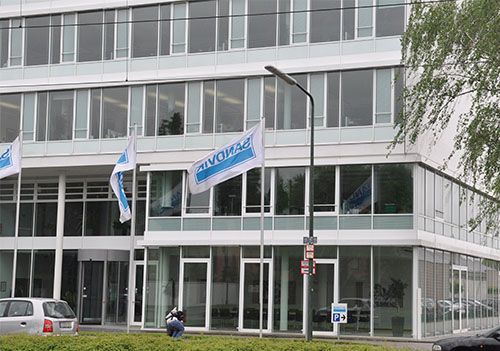
| object | Verwaltungsgebäude Sandvik Holding GmbH, Düsseldorf |
| constructor | Kai 18, Düsseldorf |
| planning | CommonConsult, Herne |
| construction year | 2005 |
| heat source | earth |
| heat pump | 3 x Typ DS, as Kaskade connected, performance total 270 kW |
| collector | 30 vertical probes, total 4000 m heating |
| operation mode | passiv cooling, activ cooling, ventilation with heat recovery |
The Sandvik Group is a global Swedish company with focus on tools for machining, mining products and metal processing (stainless steel). In 2008, the Group had 50,000 employees in 130 countries. The turnover was 93 billion Swedish krona (approx. 10 billion Euro). The German-based Sandvik Holding GmbH is located in Düsseldorf, with offices and subsidiaries in Tübingen, Renningen, Fellbach, Mörfelden-Walldorf, Frankfurt and Essen. With approx. 3900 employees, Germany contributed 7 percent (700 million Euro) to the Group's business in 2008.
Prior to the installation, a geothermal response test with building simulation (EED simulation) was performed. It had to provide information whether the soil on the premises supplies sufficient energy. The test was positive.
Based on the simulation and assuming statistical local temperature conditions, the annual energy costs for the entire building amount to 29,500 Euro for the geothermal system. The annual gas and energy bill when using a natural gas boiler with cooling unit would amount to 55,100 Euro. This results in savings of 25,600 Euro. In addition, the CO2 emissions are reduced to merely 40 percent compared to the boiler system with cooling unit.
The entire system is designed for several operating conditions
Firstly, 'Heating', involving: probe field (geothermal energy), plus heat pump system, plus concrete core activation.
Secondly, 'Natural cooling', involving: probe field (geothermal cooling, fluid temperature approx. 15 – 18 °C) plus concrete core activation, i.e. without heat pump.
Thirdly, 'Active cooling', involving: probe field (geothermal cooling), plus heat pump as cooling unit, plus concrete core activation. Furthermore, the plant manufacturer implemented a fourth circuit for ventilation and exhaust with heat recovery (in heating mode) or for passive cooling in the summer.
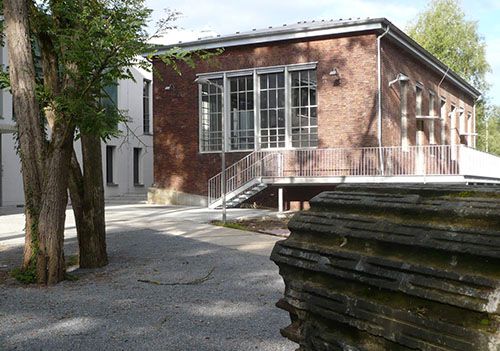
| object | cultur and service complex„Brügger Mühle“, Erkrath |
| constructor/ investor | Hasso von Blücher, Blücher Gruppe |
| planning | CommonConsult/PBS & Partner, Erkrath |
| construction year | 2005-2008 |
| heat source | rainwater/groundwater |
| heat pump | 2 x Typ DS 5136.3 |
| operation mode | heating, passiv cooling, activ cooling |
Near Düsseldorf, in the romantic Neandertal Valley where the Düssel flows through the gentle slopes, Italian quarry workers dug up 16 bone fragments and a skull in 1856. Scientists from Bonn complemented these findings with additional anatomical excavations of homo neanderthalensis. The Neanderthals made the meadow landscape world-famous. However, in the past the idyllic scenery was disturbed by an industrial wasteland in the valley with a crumbling old paper mill in the centre.
Neandertal Valley – environmental technology meets nature.
Inevitably, during the redesign, ecological factors had to play a major role. This obligation is met by the heat pump cascade. Its energy source: the reservoirs of the former paper mill. In the past, they contained the intermediate wood pulp until it softened into mush. In the "Brügger Mühle" project, the builders are assigning the task of energy storage to the reservoirs.
The entire control system was realised by the Process Control Engineering department of WATERKOTTE GmbH. It linked the reservoirs, well pumps, change-over valves as well as heating, climate and ventilation control of the entire building. The well and reservoir pumps also provide the flood protection for the premises. To allow remote control and parameterisation, the engineers set up a server in the offices of the planner PBS + Partner. This server uses modems to communicate with the sensors and actuators in the system, regularly record the operating conditions and supply the technicians with important data on operation optimisation.
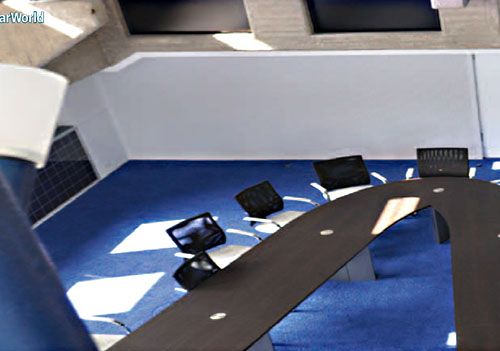
| object | modification Wasserwerk zur Firmen- zentrale, Bonn |
| constructor | Frank Asbeck, SolarWorld Holding AG |
| architect | Architekturbüro Ralph Schweitzer, Bonn |
| general enterprises | Zechbau GmbH, Niederlassung Bonn |
| planning | PBS & Partner, Erkrath |
| construction year | modification 2008/2009 |
| heat source | groundwater |
| heat pump | 4 x DS 5109, total 240 kW |
| well | historical conveyor well available, back supply over ornamental pround in the Rhein |
| operation mode | heating/cooling |
Chief Executive Frank Asbeck relocated the headquarters of SolarWorld AG to a listed, shut down waterworks premises. The rise of the city of Bonn to German capital is reflected in the architecture of the building ensemble of the former 'waterworks': At the time the old Prussian facility had to be expanded by a new high-performance building, the ornamented industrial culture of the Gründerzeit style with coarse, whitewashed masonry was joined by the very geometric glass brick architecture of the 60s.
The workplaces are scattered in the open spaces between the retired water processing plants or are located in the shut-down 4 m diameter carbon filters.
The plant engineers mounted the new 200 mm diameter groundwater pipe into the large former 700 mm diameter well water pipe. The reduction was due to the fact that a filled 700 mm cast iron pipe of several metres length has, when the heat pump is switched off, a considerable storage volume which in turn would drop by a few degrees of temperature in the winter, thus decreasing the efficiency of the heat pumps.
The corporate management feels committed to sustainable, economically, ecologically and socially justifiable growth. Not just in Germany. Under the name Solar2World the Group takes its ethical commitment to fair development also to emerging economies and developing countries. The conversion of the waterworks to the headquarters in the meadow landscape along the banks of the Rhine reflects this sustainability visibly and noticeably.
The heat pump cascade consists of two times two machines. They are connected alternately as component in order to run two different temperature levels. This is because the preservation order did not permit thermal insulation measures on the old buildings. Therefore, the cast iron radiators - in part with additional wall heating and ceiling heating elements - remain in the building. This compelled the planners to provide two temperature circuits, one high temperature circuit up to 65 °C for rooms with a high specific heat requirement and one for low temperature heat.